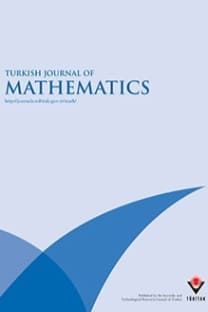Relation between matrices and the suborbital graphs by the special number sequences
Relation between matrices and the suborbital graphs by the special number sequences
___
- [1] Akbaba Ü, Deger AH, Tuylu T. On some connections between suborbital graphs and special sequences. Turkish Journal of Mathematics and Computer Science 2018; 10: 134-143.
- [2] Akbas M. On suborbital graphs for the modular group. Bulletin of the London Mathematical Society 2001; 33: 647-652. doi: 10.1112/S0024609301008311
- [3] Basin SL. The Appearance of Fibonacci numbers and the Q Matrix in electrical network theory. Mathematics Magazine 1967; 36 (2): 84-97. doi: 10.1080/0025570X.1963.11977642
- [4] Cuyt A, Petersen VB, Verdonk B, Waadeland H, Jones WB. Handbook of Continued Fractions for Special Functions. New York: Springer, 2008.
- [5] Deger AH. Relationships with the Fibonacci numbers and the special vertices of the suborbital graphs. Gümüşhane Üniversitesi Fen Bilimleri Enstitüsü Dergisi 2017; 7: 168-180 (in Turkish with an abstract in English). doi:10.17714/gufbed.2017.07.011
- [6] Deger AH. Vertices of paths of minimal lengths on suborbital graphs. Filomat 2017; 31 (4): 913-923. doi: 10.2298/FIL1704913D
- [7] Ercolano J. Matrix generator of Pell sequence. Fibonacci Quarterly 1979; 17 (1): 71-77.
- [8] Güler BÖ, Kader S, Besenk M. On congruence equations arising from suborbital graphs. Turkish Journal of Mathematics 2019; 43: 2396-2404. doi:10.3906/mat-1905-93
- [9] Güler BÖ, Kör T, Şanlı Z. Solutions to some congruence equations via suborbital graphs. SpringerPlus 2016; 5 (1327): 1-11. doi:10.1186/s40064-016-3016-5
- [10] Hoggat VE. Fibonacci and Lucas Numbers. Palo Alto: CA: Houghton- Mifflin, 1969.
- [11] Jones GA, Singerman D. Complex Functions: An Algebraic and Geometric Viewpoint. UK: Cambridge University Press, 1987.
- [12] Jones GA, Singerman D, Wicks K. The modular group and generalized farey graphs. London Mathematical Society Lecture Note Series-Cambridge University Press 1991; 160: 316–338.
- [13] Kader S, Güler BÖ. On suborbital graphs for the extended modular group Γˆ . Graph and Combinatorics 2013; 29: 1813-1825. doi: 10.1007/s00373-012-1226-3
- [14] Koshy T. Fibonacci and Lucas Numbers with Applications. New York: Wiley, 2001.
- [15] Koshy T. Pell and Pell-Lucas Numbers with Applications. New York: Springer, 2014.
- [16] Kushwaha S, Sarma R. Continued fractions arising from $F_{1,3}$ . The Ramanujan Journal 2018; 46: 605-631. doi: 10.1007/S11139-018-0013-Z
- [17] Prajapat S, Jain A, Thakur RS. A Novel approach for information security with AVK using Fibonacci Q-Matrix. International Journal of Computer - Communication Technology 2012; 3 (3): 54-57. doi: 10.47893/IJCCT.2014.1262
- [18] Sarma R, Kushwaha S, Krishnan R. Continued fractions arising from $F_{1,2}$ . Journal of Number Theory 2015; 154: 179-200. doi: 10.1016/j.jnt.2015.02.010
- [19] Sims CC. Graphs and finite permutation groups. Mathematische Zeitschrift 1967; 95: 76-86.
- [20] Stakhov AP. Fibonacci matrices, a generalization of the “Cassini formula”, and a new coding theory. Chaos, SolitonsFractals 2005; 30: 56-66. doi:10.1016/j.chaos.2005.12.054
- ISSN: 1300-0098
- Yayın Aralığı: 6
- Yayıncı: TÜBİTAK
On the paper “Generalized hyperideals in locally associative left almost semihypergroups”
A refinement of Newton and Maclaurin inequalities through abstract convexity
Gültekin TINAZTEPE, Ramazan TINAZTEPE
Construction of minimal linear codes with few weights from weakly regular plateaued functions
Existence and transportation inequalities for fractional stochastic differential equations
Abdelghani OUAHAB, Mustapha BELABBAS, Johnny HENDERSON, Fethi SOUNA
Composition laws on the Fricke surface and Markov triples
Esra Ünal YILMAZ, Abdurrahman Muhammed ULUDAĞ
Necessary conditions for extended spectral decomposable multivalued linear operators
Clairaut invariant Riemannian maps with Kähler structure
Properties of Abelian-by-cyclic shared by soluble finitely generated groups
On extended interpolative single and multivalued F -contractions
Minimal generators of annihilators of even neat elements in the exterior algebra
